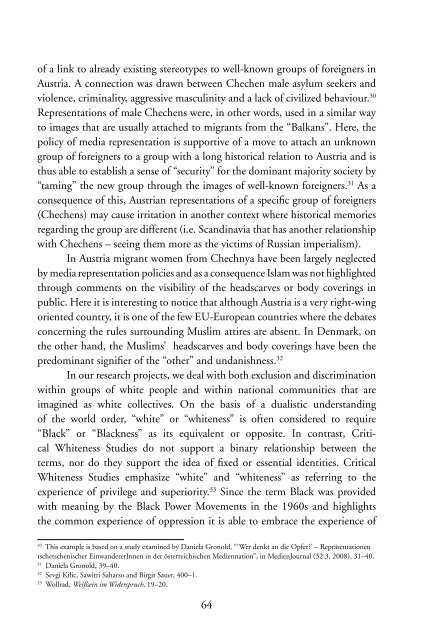Teaching with the third wave new feminists - MailChimp
Teaching with the third wave new feminists - MailChimp
Teaching with the third wave new feminists - MailChimp
Create successful ePaper yourself
Turn your PDF publications into a flip-book with our unique Google optimized e-Paper software.
of a link to already existing stereotypes to well-known groups of foreigners inAustria. A connection was drawn between Chechen male asylum seekers andviolence, criminality, aggressive masculinity and a lack of civilized behaviour. 30Representations of male Chechens were, in o<strong>the</strong>r words, used in a similar wayto images that are usually attached to migrants from <strong>the</strong> “Balkans”. Here, <strong>the</strong>policy of media representation is supportive of a move to attach an unknowngroup of foreigners to a group <strong>with</strong> a long historical relation to Austria and isthus able to establish a sense of “security” for <strong>the</strong> dominant majority society by“taming” <strong>the</strong> <strong>new</strong> group through <strong>the</strong> images of well-known foreigners. 31 As aconsequence of this, Austrian representations of a specific group of foreigners(Chechens) may cause irritation in ano<strong>the</strong>r context where historical memoriesregarding <strong>the</strong> group are different (i.e. Scandinavia that has ano<strong>the</strong>r relationship<strong>with</strong> Chechens – seeing <strong>the</strong>m more as <strong>the</strong> victims of Russian imperialism).In Austria migrant women from Chechnya have been largely neglectedby media representation policies and as a consequence Islam was not high lightedthrough comments on <strong>the</strong> visibility of <strong>the</strong> headscarves or body coverings inpublic. Here it is interesting to notice that although Austria is a very right-wingoriented country, it is one of <strong>the</strong> few EU-European countries where <strong>the</strong> debatesconcerning <strong>the</strong> rules surrounding Muslim attires are absent. In Denmark, on<strong>the</strong> o<strong>the</strong>r hand, <strong>the</strong> Muslims’ headscarves and body coverings have been <strong>the</strong>predominant signifier of <strong>the</strong> “o<strong>the</strong>r” and undanishness. 32In our research projects, we deal <strong>with</strong> both exclusion and discrimination<strong>with</strong>in groups of white people and <strong>with</strong>in national communities that areimagined as white collectives. On <strong>the</strong> basis of a dualistic understandingof <strong>the</strong> world order, “white” or “whiteness” is often considered to require“Black” or “Blackness” as its equivalent or opposite. In contrast, CriticalWhiteness Studies do not support a binary relationship between <strong>the</strong>terms, nor do <strong>the</strong>y support <strong>the</strong> idea of fixed or essential identities. CriticalWhiteness Studies emphasize “white” and “whiteness” as referring to <strong>the</strong>experience of privilege and superiority. 33 Since <strong>the</strong> term Black was provided<strong>with</strong> meaning by <strong>the</strong> Black Power Movements in <strong>the</strong> 1960s and highlights<strong>the</strong> common experience of oppression it is able to embrace <strong>the</strong> experience of30This example is based on a study examined by Daniela Gronold, “‘Wer denkt an die Opfer?’ – Repräsentationentschetschenischer EinwandererInnen in der österreichischen Mediennation”, in MedienJournal (32:3, 2008), 31–40.31Daniela Gronold, 39–40.32Sevgi Kilic, Sawitri Saharso and Birgit Sauer, 400–1.33Wollrad, Weißsein im Widerspruch, 19–20.64
















